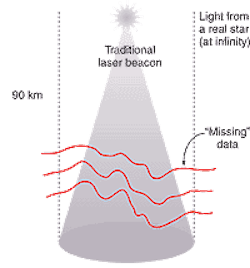
A new method of sensing the wavefront distortion from a laser guide star fixes the problem of focal anisoplanatism, say scientists at the University of Cambridge (Cambridge, England) and the University of Durham (Durham, England). In adaptive optics for astronomy, laser guide-star systems are a proven technology for monitoring and correcting atmospheric distortion in real time. But because an artificial laser guide star is focused at a finite altitude in the atmosphere, its light does not pass through the same bits of atmosphere as light from a real star or other object being observed (see figure).
This focal anisoplanatism, or so-called "cone effect," can be eliminated by launching a parallel beam rather than a focused one, says Gordon Love, a physicist at the University of Durham. The wavefront aberration is then sensed by monitoring the beam in its upward passage. The method is implemented by expanding a laser beam to fill the pupil of the telescope and propagating it up into the atmosphere as a parallel beam. Assuming the atmospheric turbulence exists largely below a height of h1 = 10 km, a camera focused at h1 images the disk of illumination from the telescope pupil, taking a snapshot of the Rayleigh backscattered radiation. When the beam is at a height h2 = 15 km, a second image is taken.
Using established methods, the intensity difference between the two images can be inverted to obtain the wavefront distortion in the upward-propagating laser beam. This configuration is effectively a curvature sensor, projecting two images of the atmosphere at different heights from the telescope pupil.
Besides a more accurate atmospheric correction for ground-based astronomical observations, another advantage is that the lower power per unit area of the beam spot will reduce hazards to aircraft and satellites. Compared to a 2-arc-sec focused spot 15 km high, a collimated laser beam 8 m in diameter will be a factor of 1000 lower in intensity.
Practical problems exist with the method, namely the assumption that the atmosphere is a perfect screen. "In reality, it may be blotchy, which would make the technique difficult to implement," says Love.
Another problem is that the lasers may not be powerful enough to form much of a signal at such a high altitude. Initial testing of the technique is scheduled this spring at the William Herschel 4.2-m telescope in La Palma, Spain.
REFERENCE
1. D. F. Buscher, G. D. Love, and R. M. Myers, Optics Lett. 27, 149 (February 2002).

Valerie Coffey-Rosich | Contributing Editor
Valerie Coffey-Rosich is a freelance science and technology writer and editor and a contributing editor for Laser Focus World; she previously served as an Associate Technical Editor (2000-2003) and a Senior Technical Editor (2007-2008) for Laser Focus World.
Valerie holds a BS in physics from the University of Nevada, Reno, and an MA in astronomy from Boston University. She specializes in editing and writing about optics, photonics, astronomy, and physics in academic, reference, and business-to-business publications. In addition to Laser Focus World, her work has appeared online and in print for clients such as the American Institute of Physics, American Heritage Dictionary, BioPhotonics, Encyclopedia Britannica, EuroPhotonics, the Optical Society of America, Photonics Focus, Photonics Spectra, Sky & Telescope, and many others. She is based in Palm Springs, California.